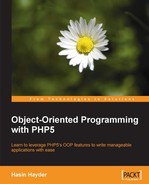Book Description
Learn to leverage PHP5's OOP features to write manageable applications with ease
General OOP concepts explained
Implement Design Patterns in your applications and solve common OOP Problems
Take full advantage of native built-in objects
Test your code by writing unit tests with PHPUnit
In Detail
Some basic objected-oriented features were added to PHP3; with PHP5 full support for object-oriented programming was added to PHP. Object-oriented programming was basically introduced to ease the development process as well as reduce the time of development by reducing the amount of code needed. OOP can greatly improve the performance of a properly planned and designed program.
This book covers all the general concepts of OOP then shows you how to make use of OOP in PHP5, with the aid of an ample number of examples.
This book will help you to understand the core object-oriented programming concepts with PHP. PHP is one of the most popular languages for web application development, and PHP5 supports OOP very well. This book will help you to master core OOP features in PHP as well as advanced Topics like Design Patterns including Model-View-Controller (MVC), and Unit Testing. It includes suggestions to help you to write good code. Moreover this book provides comprehensive documentation and working examples on the Standard PHP Library (SPL), which are hard to find elsewhere. It will really help you to leverage PHP OOP features to write manageable applications with ease.
Table of Contents
- Object-Oriented Programming with PHP5
- Credits
- About the Author
- About the Reviewers
- Introduction
- 1. OOP vs. Procedural Programming
- 2. Kick-Starting OOP
- Let's Bake Some Objects
- Using an Object
- Modifiers
- Constructors and Destructors
- Class Constants
- Extending a Class [Inheritance]
- Polymorphism
- Interface
- Abstract Class
- Static Method and Properties
- Accessor Methods
- Using Magic Methods to Set/Get Class Properties
- Magic Methods for Overloading Class Methods
- Visually Representing a Class
- Summary
- 3. More OOP
- 4. Design Patterns
- 5. Reflection and Unit Testing
- 6. Standard PHP Library
- 7. Database in an OOP Way
- 8. Cooking XML with OOP
- 9. Building Better with MVC
